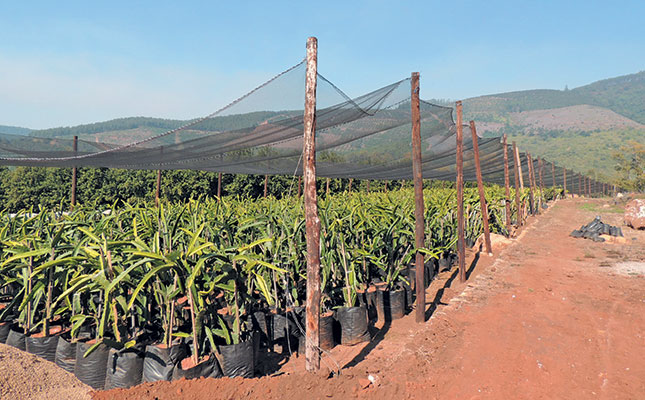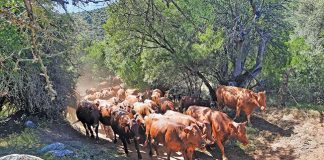
Photo: Alita van der Walt
At R50/kg, one would think more South African farmers would be producing dragon fruit. However, although local conditions are ideal for growing this cactus plant, to date plant material has been scarce in South Africa and the number of available cultivars limited. Moreover, these cultivars have not been well-received by consumers due to their bland taste.
Now new, sweeter cultivars are being made available under licence to growers by Amorentia Nursery based in Tzaneen, Limpopo. Owner Howard Blight says that he bought the plant material for 14 dragon fruit varieties from a well-known plant collector, Keith Wilson, who imported it from the US. Howard has registered these varieties under the Amorentia Sweet Dragon Fruit trademark.
Amorentia Nursery will retain the propagation rights to this series of white-, pink-, and red-fleshed cultivars, while growers will receive shares in the Amorentia Sweet Dragon Fruit marketing company.
“To date, there are fewer than 20ha of commercial dragon fruit orchards in South Africa,” says Blight. “The plants in these orchards can easily be top-grafted over to the new sweet varieties.”
The dragon fruit, or pitaya, is indigenous to South and Central America, and the name refers to the fruit of several cactus species. Most commercially grown dragon fruit cultivars belong to the Hylocereus.undatus species and hybrids of these.
Fast production
The dragon fruit plant is ideally suited to tropical and subtropical conditions.
“Under the right conditions and in soil with a high organic matter content, plants can flower and bear fruit up to five times a year,” says Blight. “The grower can expect some production in the second year after planting.”
The optimal growing temperature for dragon fruit is between 21°C and 29°C, but the plant can survive temperatures as high as 41°C and as low as -1°C for short periods. The plant is not resistant to frost, however, and needs 500mm to 1 500mm of rainfall annually, with alternate dry and wet conditions, or must be grown under permanent irrigation.
Blight warns against over-irrigating the plants, however, as this can cause the flowers to fall off and fruit to burst.
“For commercial planting in high-rainfall regions, I would suggest planting them on ridges with well composted organic matter and good drainage.”
High-density planting
The plant is suitable for ultra-high density plantings in rows ranging from 1 000 to 1 250 plants/ha at 2m x 5m, or 2m x 4m apart. Each plant can be trained up a single post to 1,8m above the ground or on a trellising system, with the branches hanging over the top and down to the ground. The fruit is formed on the branches.
The plants need up to 12 hours of sunlight to stimulate flowering. Using artificial light in the early autumn and late spring will therefore increase the harvest, says Blight. Dragon fruit flowers bloom only once a year at night, and are between 25cm and 30cm in length and between 15cm and 17cm in width. Moths and bats pollinate the flowers at night, and in the early morning bees continue the task, before the flowers close up again.
The fruit matures within a month, changing colour to red 27 to 33 days after pollination. At this stage it is ripe and ready for harvesting. Ideally, this should take place within a few days of the colour change.
One of the main benefits of dragon fruit is that the plant bears fruit in its second year after planting. In orchards, the plants will reach full production within five years, with yields ranging between 20t/ha and 30t/ ha, depending on the growing conditions, Blight explains.
Packing and distribution
For local distribution, fruit can be packed and stored in temperatures ranging from 10°C and 14°C, ensuring a shelf life of about two weeks. For the export market, fruit should be stored at 3°C to 5°C for a shelf life of between 24 and 40 days.
Dragon fruit crops are harvested in summer, the off-season for avocados.
“Avocado farmers are ideally equipped to grow dragon fruit, as the fruit are approximately the same size and can be packed in the same packhouse, using the same equipment and infrastructure,” he says.
Dragon fruit does not bruise as easily as avocados and is hardier and more able to withstand drought.
“Many farmers in California in the US are now beginning to replace avocado orchards with dragon fruit because it requires significantly less water, says Blight.
Phone Howard Blight on 082 872 0807 or email [email protected] or visit amorentia.co.za/dragon-fruit













